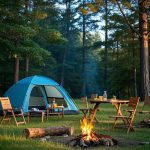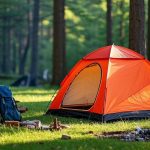Planning a family camping trip? Use these 7 proven tips for choosing campground locations that are safe, fun, and perfect for all ages.

Table of Contents
Introduction
Looking back at common family camping disasters, many parents wish they had learned the art of choosing campground locations properly. Picture this: three cranky kids, no cell service, and bathrooms that were a half-mile hike through what felt like a jungle. These weekends teach families everything about what NOT to look for when selecting a family-friendly spot.
After years of family camping experiences and countless trial-and-error situations, many families have finally cracked the code on choosing campground destinations that actually work for families. Trust me, there’s a huge difference between a romantic getaway spot and a place where your 8-year-old won’t have a meltdown because there’s nothing to do.
The Ultimate Guide to Choosing Campground Locations That Work
1. Start With Your Family’s Non-Negotiables
When families start choosing campground options, they should always begin with what their family absolutely needs versus what would be nice to have. For many families, clean bathrooms within 200 feet of their site become non-negotiable after that first disaster trip. Young children have tiny bladders, and midnight bathroom runs shouldn’t require a GPS device.
Here’s an essential checklist that’s saved countless families from camping nightmares:
- Restrooms with running water (seriously, pit toilets with toddlers are brutal)
- Level camping spots for easier tent setup
- Potable water access within reasonable walking distance
- Some form of camp store or nearby supplies
Before setting up camp, make sure you have all the essentials covered in our comprehensive camping checklist to ensure nothing important gets left behind.
2. The Distance Dilemma: How Far Is Too Far?
One of the biggest mistakes families make early on is choosing campground locations based purely on photos, completely ignoring drive time. Three hours in a car with excited kids feels like an eternity, especially when they’re asking “are we there yet?” every five minutes.
Most experienced camping families have learned the sweet spot is about 90 minutes max from home for weekend trips. This gives enough of that “getting away” feeling without turning the drive into an endurance test. For longer vacations, families should break up the journey with overnight stops or plan activities along the way.
The National Park Service provides excellent resources for planning family-friendly camping trips and understanding reservation systems across different parks.
Research shows that 68% of families prefer campgrounds within two hours of their home base for weekend trips. That statistic makes total sense once you factor in setup time, driving fatigue, and the reality of Sunday traffic heading home.
3. Amenities That Actually Matter for Families
When choosing campground facilities, families often get excited about fancy amenities like boat rentals or golf courses. Then they realize their kids couldn’t care less about those things. What children DO care about is having a playground nearby, swimming opportunities, and other families around.
The game-changers for family camping success are often the simple things:
- Playgrounds within sight of your campsite
- Swimming areas (even if it’s just a small lake)
- Nature programs or junior ranger activities
- Fire ring and picnic table at each site
- Level ground for games and running around
Having the right shelter makes all the difference too – check out our guide to the best family camping tents to ensure everyone stays comfortable and dry.
Many families notice that choosing campground locations with swimming access reduces sibling arguments by about 75%. There’s something magical about water that keeps kids entertained for hours.
4. Safety Considerations You Might Miss
Safety should be every family’s top priority when choosing campground destinations. Many families have experienced close calls at campgrounds where children wandered toward what looked like gentle streams but were actually moving much faster than they appeared. These incidents teach families to research potential hazards before choosing campground destinations.
Families should always check for:
- Traffic patterns within the campground (some have vehicles constantly driving through)
- Natural hazards like steep drop-offs, fast-moving water, or unstable ground
- Wildlife activity in the area (bear country requires different preparation)
- Emergency services proximity and cell phone coverage
For families new to outdoor adventures, our camping with kids guide provides essential safety tips and strategies for keeping everyone safe and happy during your trip.
KOA’s Safety Guidelines offer comprehensive safety protocols that families should review before any camping adventure.
5. Reading Reviews Like a Detective
Experienced camping families have gotten pretty good at reading between the lines when choosing campground options based on online reviews. When someone says “rustic charm”, they often mean “prepare for bugs and minimal facilities”. When they mention “peaceful and quiet”, it might mean “boring for kids”.
Look for reviews from other families with similar-aged children. They’ll mention things like whether the bathrooms have changing tables, if the playground equipment is safe for toddlers, or if there are hiking trails suitable for short legs.
The most helpful reviews usually come from families who visited during the same season you’re planning. A campground that’s perfect in September might be a muddy mess in April.
ReserveAmerica and Campground Reviews provide extensive user reviews and detailed information about facilities and amenities at thousands of campgrounds across the country.
6. Booking Strategies That Save Your Sanity
Choosing campground reservations used to stress families out until they figured out the system. Popular family-friendly campgrounds often book up 5-6 months in advance, especially for summer weekends. Many families learn this the hard way when they show up to “first-come, first-served” campgrounds on Memorial Day weekend and find lines of RVs waiting for spots.
Smart booking strategies include:
- Make reservations as soon as they open (many state parks open bookings exactly 6 months out)
- Have backup options ready when choosing campground alternatives
- Consider slightly less popular campgrounds that might offer the same amenities
- Book mid-week stays when possible for better availability and lower crowds
7. Testing the Waters: Start Small
Before committing to week-long vacations, experienced campers always recommend test runs when choosing campground experiences for families. Starting with one-night stays relatively close to home helps families figure out what gear they actually need, what their kids can handle, and what their family’s camping style really is.
These test runs often reveal that many families prefer developed campgrounds over primitive camping, at least while the kids are young. Families discover that having electrical hookups means happier kids (they can charge devices for quiet time) and less stressed parents.
Once you’ve found the perfect spot, knowing how to set up a campsite efficiently can make the difference between a smooth start and a chaotic arrival.
8. Budget-Friendly Choosing Campground Strategies
Camping can get expensive quickly if families aren’t careful about choosing campground pricing options. State parks typically offer the best value for families, with rates usually ranging from $15-35 per night compared to private campgrounds that can charge $50+ per night.
Many families have found that choosing campground locations during shoulder seasons (late spring or early fall) can save 30-40% on fees while offering better availability and fewer crowds. Plus, cooler temperatures mean less cranky kids and better sleeping conditions.
Good Sam Club offers discounts at thousands of campgrounds across North America, potentially saving families hundreds of dollars on camping fees throughout the year.
9. The Weather Factor
Weather can make or break a camping trip, so families should always check historical weather patterns when choosing campground destinations. That beautiful mountain campground might be perfect in July but completely inaccessible in May due to snow.
Experienced campers have learned to pack for weather that’s 10-15 degrees cooler than predicted, especially for mountain camping. Elevation changes everything, and nothing ruins a trip faster than unprepared, cold kids.
Making the Final Decision
After all this research, choosing campground locations can still feel overwhelming. Many families use a simple scoring system: each potential campground gets rated 1-5 on safety, amenities, distance, cost, and reviews. The highest total score usually wins, but families should also trust their gut feeling about whether a place feels right for their specific needs.
Conclusion
Choosing campground destinations doesn’t have to be stressful once you know what to look for. The key is being honest about your family’s needs and expectations rather than trying to create some Instagram-perfect camping experience.
Remember, the best campground is the one where your family can relax, have fun, and make memories together. Sometimes that means sacrificing the scenic mountain views for a spot with better bathrooms and a playground. And you know what? That’s perfectly okay.
Start with shorter trips close to home, learn what works for your family, and gradually expand your choosing campground adventures from there. Before you know it, you’ll have your own list of go-to spots that your kids will beg to revisit year after year.







